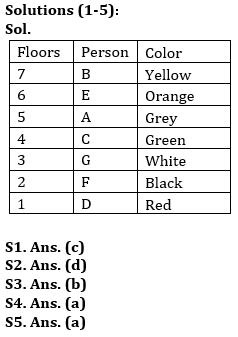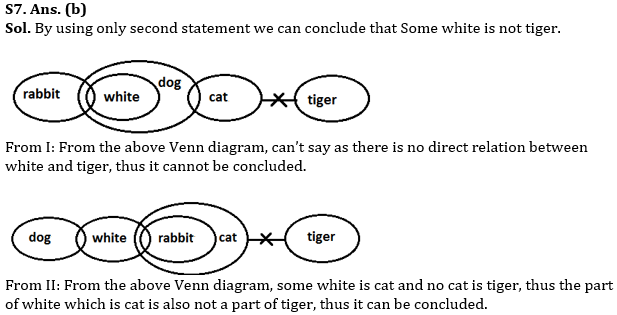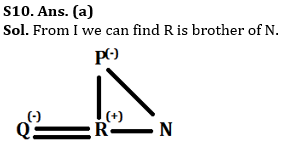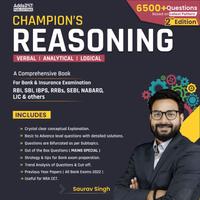Directions (1-5): Study the following information carefully and answer the following questions.
Seven people live on seven different floors from top to bottom such that ground floor is numbered as 1 and so on up to top floor is numbered as 7. They all like different colours i.e., Yellow, Orange, Grey, Green, White, Black and Red.
C lives on an even numbered floor and likes Green. There are two floors between the floor on which C and D live. G lives just above the floor on which F lives who likes Black. There are two floors between the floor on which F and A live. A lives on one of the floors above the floor on which G lives. B lives on one of the floors above E. E lives neither on first nor on fifth number floor. There are two people live between the one who likes Yellow and C. Only two people live between the one who likes Red and the one who likes Green. B doesn’t like Red. The person who likes orange lives immediately above the person who likes Grey.
Q1. How many people live between D and E?
(a) One
(b) Three
(c) Four
(d) Two
(e) None of these
Q2. Which is the correct combination for the person who lives on floor number Seven?
(a) D, Green
(b) C, Grey
(c) A, Orange
(d) B, Yellow
(e) F, Black
Q3. How many persons live between F and the one who likes Grey?
(a) One
(b) Two
(c) Five
(d) Three
(e) None of these
Q4. Who likes White?
(a) G
(b) H
(c) A
(d) E
(e) C
Q5. Four of the following five are alike in a certain way based on the given arrangement and thus form a group. Who is the one that does not like that group?
(a) F
(b) D
(c) G
(d) B
(e) A
Directions (6-10): Each of the questions below consists of a question and two statements numbered I and II given below it. You have to decide whether the data provided in the statement are sufficient to answer the question. Read both the statements and Give answer:
(a) If the data in statement I alone are sufficient to answer the question while the data in statement II alone are not sufficient to answer the question.
(b) If the data in statement II alone are sufficient to answer the question while the data in statement, I alone are not sufficient to answer the question.
(c) If the data either in statement I alone or in statement II alone are sufficient to answer the question.
(d) If the data even in both statements I and II together are not sufficient to answer the question.
(e) If the data in both statement I and II together are necessary to answer the question.
Q6. Who sits third to the left of P, if all persons sit in a row are facing south?
I. Seven persons are sitting in a row. N sits exactly in the middle of the row. Two people sit between N and S.
II. R sits to the immediate left of N. Only one person sits between R and O. Q sits third to the left of O. M sits fourth to the left of O.
Q7. By using which statement, we can conclude ‘Some white is not tiger’?
I. All white is dog. Some white is rabbit. Some cat is dog. No cat is tiger.
II. Some dog is white. Some white is rabbit. All rabbit is cat. No cat is tiger.
Q8. Who among R, S, K, P and M is exactly in the middle when they are arranged in ascending order of their heights?
I. P is taller than S but shorter than M.
II. K is taller than S and M but shorter than R.
Q9. How is ‘Life’ written in a code language?
I. ‘Over your life’ is written as ‘mn lo kc’ and ‘your life gift’ is written as ‘mn lo bd’ in that code language.
II. ‘market claim lead’ is written as ‘st jk cd’ and ‘digital life key’ is written as ‘lo pq jk’ in that code language.
Q10. How is R related to N?
I. P who has only two kids R and N, is the mother-in-law of Q who is sister-in-law of N.
II. S the sister-in-law of R and the daughter-in-law of T who has only two kids R and N.
Solutions



S8. Ans. (e)
Sol. From I, we have: M > P> S.
From II, we have: K > S, K > M, R > K.
Combining the above two, we have: R>K>M>P>S
Clearly, M is in the middle.
S9. Ans. (e)
Sol. By combining both the statements together we can find that code of ‘Life’ is ‘lo’.






 50+ Data Sufficiency Questions For Bank ...
50+ Data Sufficiency Questions For Bank ...
 Quantitative Aptitude Quiz For Bank Main...
Quantitative Aptitude Quiz For Bank Main...





